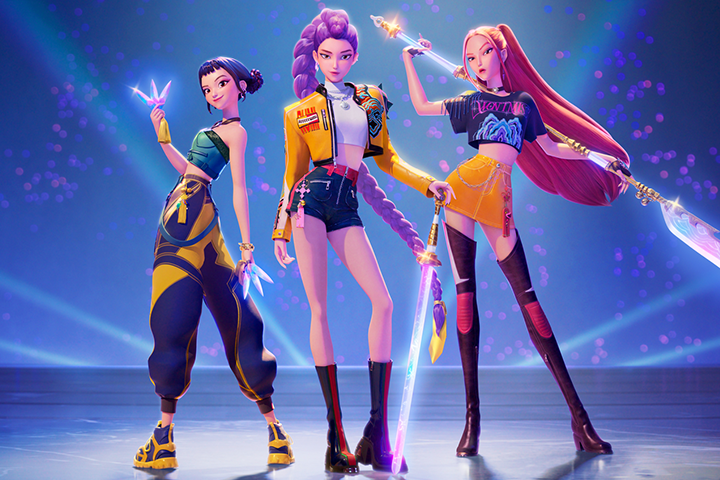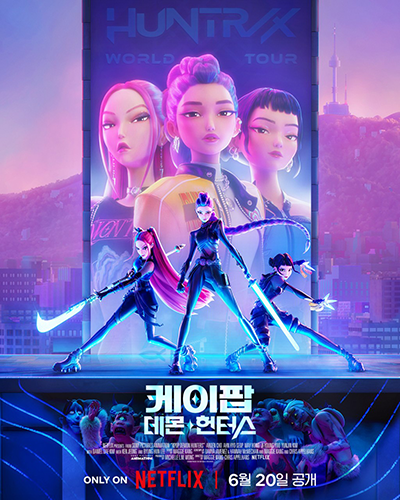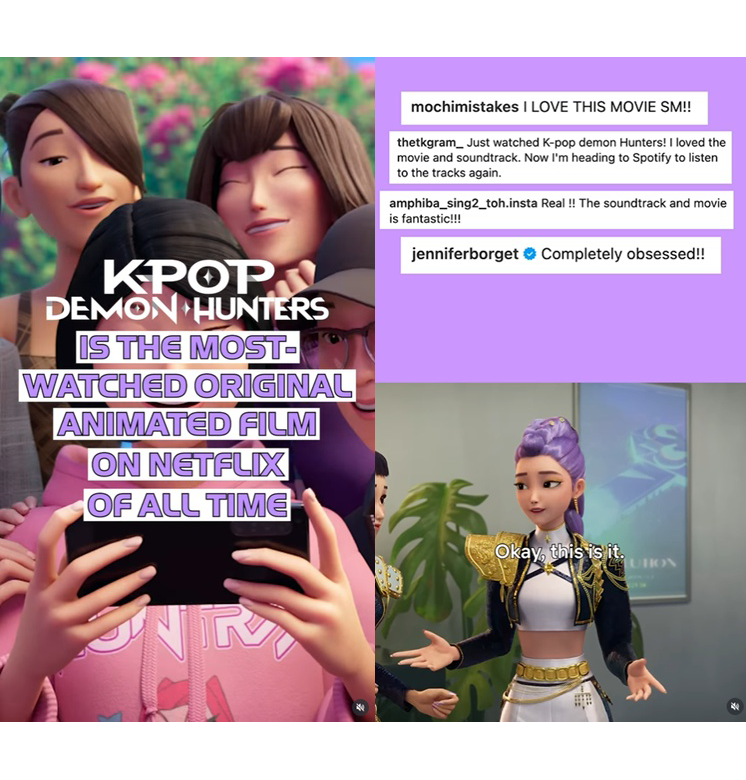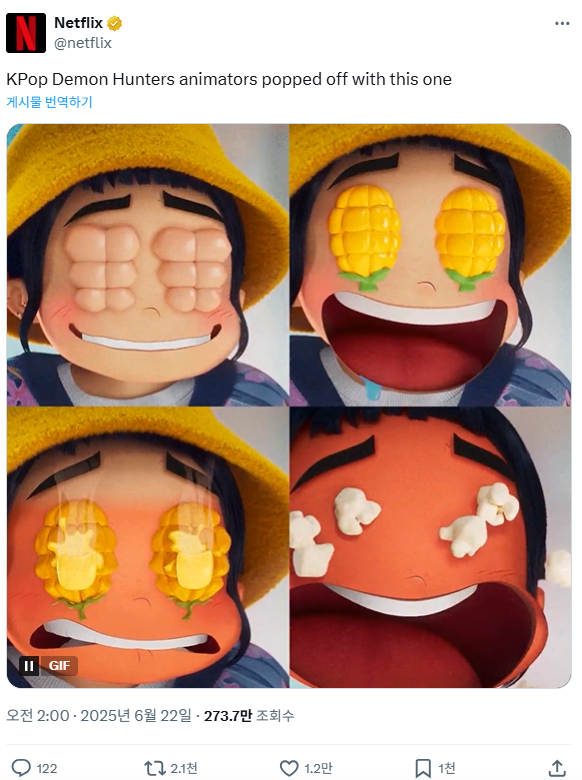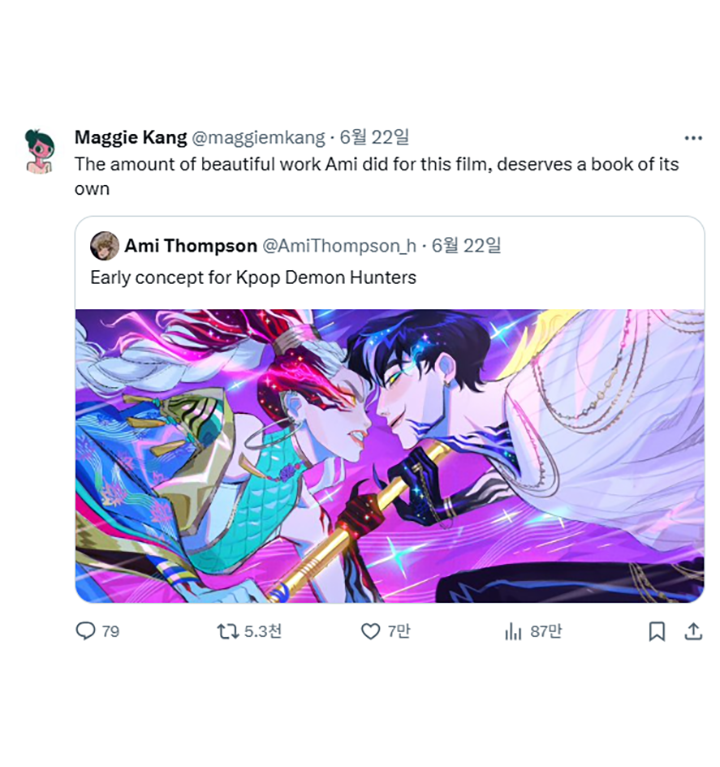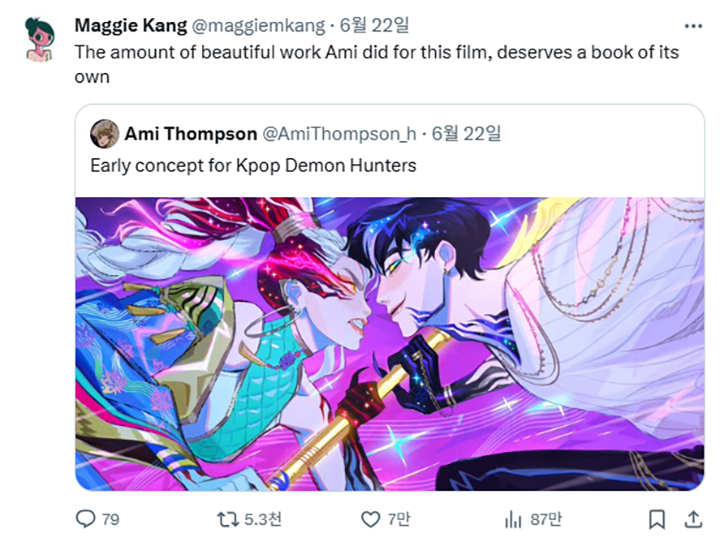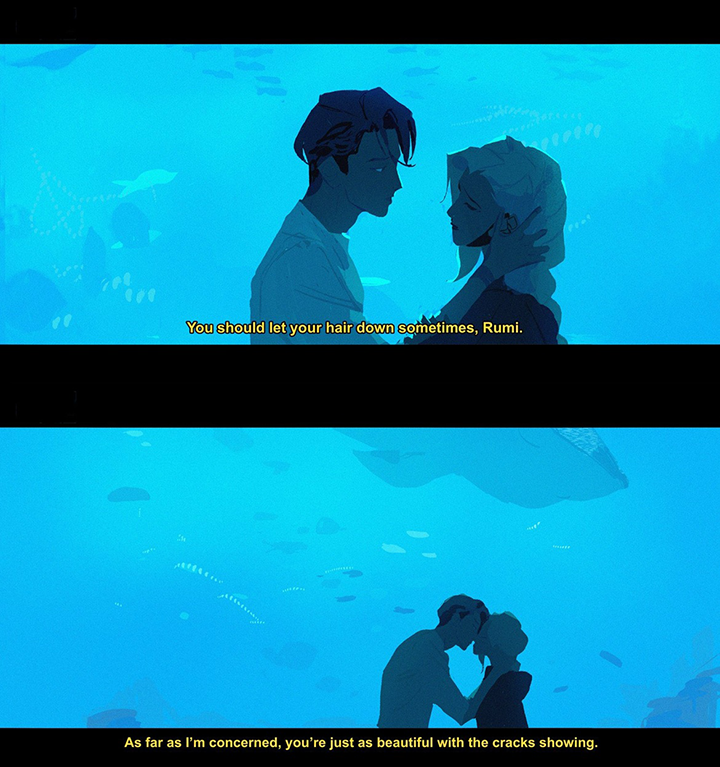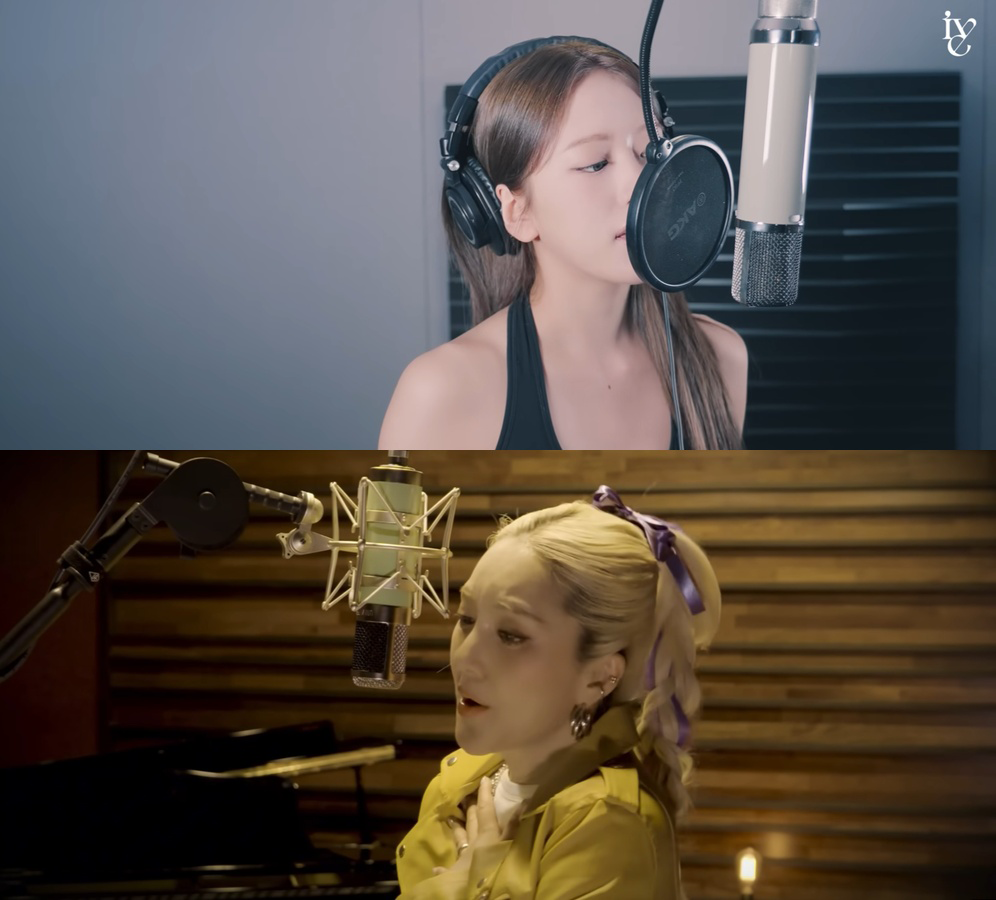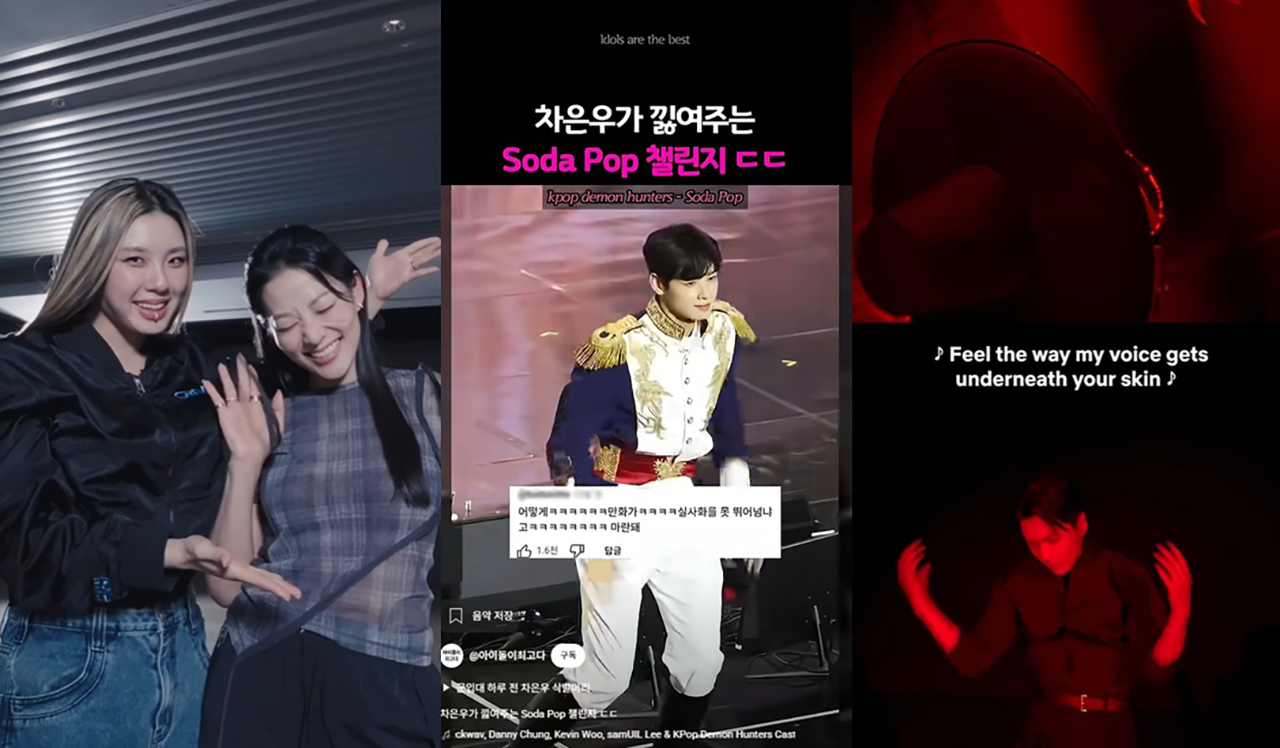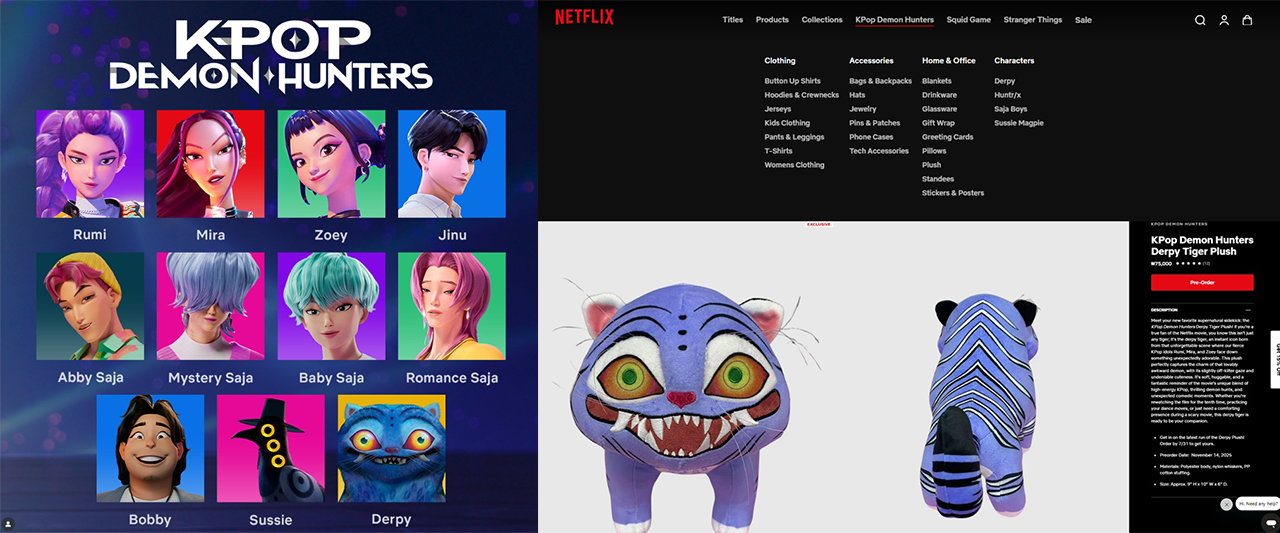K-컬처를 전방위로 녹여 세계를 사로잡은 애니메이션
<케이팝 데몬 헌터스>
소니 픽처스 애니메이션이 만든 <케이팝 데몬 헌터스>의 6월 20일 넷플릭스 공개 소식이 들렸을 때 반신반의하는 마음이었다. 우선 설정부터 걱정스러웠다. K-팝과 퇴마의 조합은 성공하면 기상천외할 테지만 실패하면 우스꽝스러울 수 있는 무리수 같았다. K-팝 아이돌이 사실은 춤과 노래로 악령을 물리치는 퇴마사라는 설정이 과연 설득력이 있을지 의문이었다. 게다가 영화 제작 소식이 들려온 2021년은 방탄소년단(BTS), 블랙핑크, 트와이스를 필두로 K-팝 열풍이 불었던 해다. 서브컬처에 가까운 문화였던 K-컬처가 보편적인 문화가 된 시기다.
그만큼 <케이팝 데몬 헌터스>는 K-팝 열풍에 편승한 소재주의라는 오해를 살 만한 기획이었다. 물론 미더운 점도 있었다. 소니 픽처스가 <스파이더맨> 유니버스 시리즈 제작사라는 점이다. 예고편에 나온 영화 속 걸그룹 ‘헌트릭스’와 당산나무와 도깨비를 모티브로 한 보이그룹 ‘사자보이즈’의 캐릭터 디자인, 안무와 의상, 화려한 액션은 ‘비주얼 하나는 믿고 볼 만한 영화’라는 신뢰감을 줬다. 게다가 곳곳에 삽입된 사인검을 바탕으로 한 주인공 루미의 무기와 혼문 등 K-문화가 자세하게 녹아든 디테일이 인상적이었다. 이러한 디테일이 H.O.T.와 서태지와 아이들 같은 1세대 K-팝 그룹에서 시작된 K-팝에 대한 오랜 애정과 자신의 뿌리에 대한 러브레터라는 한국계 캐나다인 매기 강 감독의 제작 의도에 진심이 반영되었다는 증거로 보이기도 했다.
넷플릭스 오리지널 애니메이션 영화 역대 시청률 1위에 오른
<케이팝 데몬 헌터스>
(제공=넷플릭스 공식 인스타그램 계정)
조이의 눈에서 팝콘이 나오는 영상은 하나의 밈으로 자리 잡았다
(제공=넷플릭스 공식 X 계정)
뜻밖의 글로벌 히트 - 커버부터 댄스 챌린지,
밈 생산까지
<케이팝 데몬 헌터스>는 우려와 달리 평단과 관객을 모두 사로잡으며 세계적인 흥행에 성공했다. 우선 속편 혹은 유명 원작 지식재산권(IP)에 기반한 작품을 만드는 영화계의 관성을 정면으로 거슬러 제작한 독창적인 오리지널 콘텐츠인 점이 평단의 큰 호감을 샀다. 영국 일간지 가디언은 “디즈니, 픽사, 일루미네이션, 드림웍스 등에서 수많은 속편이 쏟아진 후, <케이팝 데몬 헌터스>는 특히 어린이들이 새로운 것을 갈망한다는 것을 상기시킨다”1는 평을 남겼다. 또한 버라이어티는 디즈니와 픽사, 일루미네이션 등 스튜디오의 관성화된 연출보다 “훨씬 더 유쾌한 접근 방식을 택했고, 한국 웹툰과 만화 등에서 영감을 받은 점”2 을 높게 샀다. 특히 헌트릭스 멤버 조이가 사자보이즈를 마주했을 때 두 눈에서 팝콘이 나오는 등의 연출은 일본 애니메이션을 보는 듯하면서도 독특함이 엿보인다. 이런 디테일을 제외해도 거의 10년 가까이 구상된 <케이팝 데몬 헌터스>의 신선한 기획과 그것을 마음껏 펼치는 자유로운 작화와 동서양 혼종의 스타일이 업계 전체에 큰 차별점으로 다가갔을 것이다. “K-팝의 시장 확대와 아시아 애니메이션 팬들이 서양의 작품에서 애니메이션의 시각적 스타일에 K-컬처를 명확히 차용한 작품을 즐기려는 수요가 맞물린 결과”3 라는 의견도 있었다.
1 https://www.theguardian.com/film/2025/jul/31/kpop-demon-hunters-netflix-animation
2 https://variety.com/2025/film/reviews/kpop-demon-hunters-review-1236437235/
3 위와 같은 링크
관객 반응도 눈여겨볼 만하다. 지금도 실시간으로 수많은 기록을 경신 중이다. 우선, 넷플릭스 오리지널 애니메이션 영화 역대 시청률 1위에 올랐다. 오리지널사운드트랙(OST)인 ‘골든(Golden)’은 빌보드 핫 100 1위(8월 11일 기준)에 올랐다. 나아가 내년 미국 아카데미 시상식 주제가상 부문의 유력 후보로 불리고 있다. 인터넷은 더욱 뜨겁다. 소셜네트워크서비스(SNS)와 유튜브는 이 영화에서 파생된 밈과 사자보이즈의 ‘소다팝(Soda Pop)’ 챌린지, 헌트릭스 ‘골든’ 커버 영상으로 도배되었다. 나아가 루미와 진우, 애비 등 영화 속 캐릭터를 코스프레하고, 헌트릭스의 조이처럼 메이크업을 하는 것이 K-팝 스타일 메이크업인 것처럼 틱톡(TikTok)에서 챌린지 되고 있다. 영화 속 팬처럼 루미와 진우의 커플링을 응원하는 ‘루진우’를 그리는 2차 창작물이 쏟아지기도 했다. 에스파의 ‘광야’ 세계관 속 멤버들을 돕는 조력자 역할로 등장했던 버추얼 아티스트 나이비스, 버추얼 그룹 플레이브를 시작으로 버추얼 아이돌이 일상화되고 있는 흐름이 사자보이즈와 헌트릭스에 대한 열광적인 인기를 가능케 한 면도 있는 것으로 보인다.
<케이팝 데몬 헌터스> 팬은 나아가 제작진 인스타그램이나 감독 인터뷰, 트리비아를 샅샅이 뒤지기 시작했다. 루미와 진우가 키스하는 장면, 아쿠아리움에서 데이트하는 장면, 귀마가 있는 곳이 궁궐이었다는 점, 헌트릭스와 사자보이즈의 첫 만남 장소가 원래 아이돌 육상대회라는 점 등 콘티나 비하인드 장면, 삭제된 장면을 발굴해 작품을 둘러싼 상상의 나래를 펼친다. 나아가 곳곳의 디테일을 연구하면서 저만의 해석을 펼치기도 한다.
SNS에서 공유되고 있는 <케이팝 데몬 헌터스> 제작 초기 콘셉트(제공=매기 강 감독, 캐릭터 디자이너 마리옹 보르데네 X 계정)
<케이팝 데몬 헌터스> 인기 요인 1 – 할리우드식 ‘아는 맛’과 ‘K-컬처’ 디테일의 조화
왜 이토록 <케이팝 데몬 헌터스>가 인기를 누리는 것일까. 사실 이야기는 꽤 익숙한 편이다. 특히 헌트릭스의 설정은 <버피 더 뱀파이어 슬레이어>(1997~2003)라는 한국에서도 인기리에 방영된 미국 드라마를 빌렸다. 이 드라마에는 뱀파이어 사냥꾼이라는 정체를 은폐해야 하는 퀸카 버피 서머즈(사라 미셸 겔러)와 그녀를 도우는 팀이 등장한다. 매기 강 감독은 한 인터뷰에서 7년 전 즈음 <케이팝 데몬 헌터스>가 한국 문화를 그리는 퇴마 영화로 기획을 시작했다고 했다. 그런 아이디어를 발전시키던 중 루미를 강렬한 여전사로 설정했다. 그리고 다음 나머지 두 멤버 조이와 미라를 더할 때 <버피 더 뱀파이어 슬레이어>의 영향을 받았다는 사실을 밝혔다. 거기다 루미는 마치 <겨울왕국>(2013) 속 엘사를 보는 듯하다. 악령을 조종하는 귀마는 <드래곤 길들이기>(2010)의 빌런 레드 데스와 닮아 있다. ‘루진우’의 로맨스도 청소년 소설을 보는 듯하다.
이처럼 <케이팝 데몬 헌터스>는 할리우드에서 흥행한 콘텐츠의 정수를 모아 둔 전형적인 스토리라인을 가지고 있다. ‘아는 맛’이라 할 수 있는 전형성이 독특한 소재와 디테일이 만드는 충격의 완충재가 되는 셈이다. 물론 이 이야기에 단점이 없지 않다. 90분이라는 짧은 러닝 타임에 7곡의 뮤지컬 시퀀스를 배치하는 타이트한 구성상 전개가 빠르고, 몇몇 장면의 연결이 성기다. 무엇보다 각 캐릭터의 감정이 깊이 다루어지지 않는다. 특히 엔딩 직전 루미가 자신을 키워준 셀린과 다툰 후 콘서트에 설 때 스토리가 뭉개지는 점이 아쉬움을 남긴다.
결국 <케이팝 데몬 헌터스>의 매력은 가장 할리우드적인 서사와 K-컬처를 깊숙이 반영한 디테일의 이질적 조화다. 이 영화는 처음부터 끝까지 한국 문화에 대한 무한한 애정이 두드러지지만 거기에서 그치지 않는다. 매기 강 감독은 제작진 대부분을 한국인 혹은 한국계 미국인으로 고용했고, 그들의 의견을 적극 들으며 한국을 오가면서 영화를 제작하는 정성을 보인다. 그 끝에 외국인에게도 익숙한 남산타워 같은 랜드마크나 고궁 데이트부터 한국인에게 익숙한 한약과 전통 민화 <작호도>에서 갓 나온 더피(호랑이)와 서시(까치), 동묘 시장 패션을 입은 중년 여성, 뚝섬유원지역(현재 자양역), 헌트릭스의 개량 한복까지 스펙트럼이 다양하게 펼쳐진 세계관이 완성되었다. 거기에 MBC 에브리원(every1)에서 방영되고 있는 <주간 아이돌>을 보는 듯한 프로그램에 나온 헌트릭스와 사자보이즈가 선후배 관계로 얘기되는 것, 숟가락 밑에 휴지를 까는 행동 등의 ‘한국식’ 예의도 구현했다.
무엇보다 <케이팝 데몬 헌터스> 속 시대별 데몬 헌터들을 소개할 때 1939년 최초의 걸그룹 저고리 시스터즈, 1950년대 국제 무대로 진출한 걸그룹 김시스터즈, 1990년대 본격적인 K-팝 아이돌 S.E.S를 오마주한 점이 감동적으로 다가온다. 나아가 매기 강 감독이 가장 심혈을 기울인 장면 중 하나로 밝힌, 헌트릭스와 사자보이즈가 한의원 앞에서 부딪히는 장면은 감독의 K-콘텐츠 사랑을 가장 잘 드러낸다. 두 그룹의 리더 진우와 루미가 부딪치는 순간 슬로모션이 되면서 멜로망스의 노래 ‘사랑인가 봐’가 흘러나오는 것을 볼 때 한국 관객은 손발이 오그라들 것이다. 이 장면이 2000년대 초반에 유행했던 뮤직비디오와 K-아침드라마의 클리셰이기 때문이다. 매기 강 감독은 이런 부끄러운 흑역사마저 사랑한다고 고백하는 듯하다.
<케이팝 데몬 헌터스> OST ‘골든’ 커버 영상을 올린 아이브(IVE) 안유진과 S.E.S 바다(제공=아이브, 바다 유튜브 채널)
<케이팝 데몬 헌터스> 안무를 맡은 리정과 루미 목소리 연기를 한 아덴 조의 댄스 콜라보, 차은우의 ‘소다팝’ 챌린지, 엔하이픈 제이의 ‘유어 아이돌(Your Idol)’ 챌린지 영상
(제공=아덴 조 인스타그램 계정, ‘아이돌이 최고다’ 유튜브 채널, 소니 픽처스 애니메이션 공식 인스타그램 계정)
<케이팝 데몬 헌터스> 인기 요인 2 -‘K-팝’을 향한 끝 모를 낙천성
<케이팝 데몬 헌터스>가 가진 또 하나의 매력은 K-팝에 대한 끝 모를 낙천성이다. 물론 K-팝 자체에 대한 구현은 훌륭하다. 헌트릭스는 블랙핑크와 트와이스, 있지(ITZY) 등에 영향을 받아서 제작되었으며 사자보이즈는 투모로우바이투게더(TXT), 방탄소년단(BTS), 스트레이키즈, 에이티즈, 빅뱅, 몬스타엑스 등에 영향을 받아서 제작되었다. 진우는 차은우와 남주혁을 모티브로 했다. 음악은 국내 연예기획사 더블랙레이블과 협력했고, SM엔터테인먼트 연습생 출신 작곡가 이재(EJAE)에게 작곡과 보컬을, 댄서 리정과 잼 리퍼블릭에 안무를 맡겼다. 트와이스가 OST ‘테이크 다운(Take down)’에 참여하는 등 OST 작곡가는 아이돌 타이틀 곡을 제작하듯이 작업했다.
그러나 다만 K-팝을 밝게만 다루어도 되는 것일까. 이미 우리는 K-팝 시스템의 심연과 그 폐해를 익히 체험했다. 아이돌은 ‘흠집과 두려움을 보이면 안 되는’ 통제된 환경 아래서 고통받는다. “아이돌 아티스트들의 성적 대상화, 그와 결부되는 건강 문제, 아티스트 및 스태프 모두의 열악한 노동 조건, 소속사와 아티스트 사이의 위계 관계, 감정적으로 아티스트를 착취하는 팬들과 그러한 착취를 적극적으로 조장하는 소속사들, 기약 없는 연습생 생활, 데뷔하더라도 종종 제 몫을 제대로 정산 받지 못하는 산업 구조”4 에 더해 감정 노동 등이 그 문제일 것이다. 이런 환경 가운데 생긴 아이돌들의 여러 비극적인 사건은 우리에게 트라우마로 남아 있다.
매기 강 감독도 같은 고민을 한 듯하다. 그는 어느 한국 작가가 “음악 산업의 어둠에 더 초점을 맞추지 않는 것에 대해 조금 혼란스럽다”고 했다는 말도 전했다. 왜 이렇게까지 낙천적으로 그리느냐는 질문에 대한 매기 강의 답은 “한국 문화를 다루는 첫 번째 영화이기 때문에, 부정적인 측면으로 시작하고 싶지 않았다”5 는 것이다. 이 낙천성이 K-팝에 대한 관심을 올려주었으니 다행이긴 하다. 더불어 이미 속편도 제작될 분위기일 터이니 K-팝의 명암을 후속편에 다루지 않을까 하는 희망이 있다. 한편으로는 어쩌면 이 애니메이션을 시작으로 K-팝을 힙한 이미지로 소비하고, 이를 안전한 상품으로만 소비하게 될지 모른다는 우려도 생긴다. 8월 29일 공개될 애플TV+의 K-팝 경연 서바이벌 <케이팝드(KPOPPED)>를 기대와 우려 섞인 시선으로 볼 수밖에 없는 이유다.
4 안희제, 망설이는사랑, 오월의봄, p.15-16
5 https://mashable.com/article/k-pop-demon-hunters-maggie-kang-chris-appelhans-interview
넷플릭스 프로필 관리에서 <케이팝 데몬 헌터스> 캐릭터로 프로필 사진을 바꿀 수 있다.
<케이팝 데몬 헌터스> 굿즈를 판매하는 넷플릭스(제공=넷플릭스 공식 인스타그램 계정, 온라인 숍 홈페이지)
<케이팝 데몬 헌터스>, 정확하고 놀라운 ‘K-컬처’의 증거
누군가는 <케이팝 데몬 헌터스>가 한국인의 눈으로 외국인이 촬영한 브이로그(Vlog), K-컬처에 대한 먹방과 리액션 영상, 인터넷 밈에서 드러나는 K-컬처에 대한 피상적 이미지를 재현한다고 지적할 수 있다. 이는 꽤 합리적인 비판일 것이다. 여기에 반론을 더하고 싶다. <케이팝 데몬 헌터스>는 이민자 서사다. 매기 강의 연출은 한국적인 것(미장센)과 미국적인 것(이야기) 사이의 갈등을 설정한 후, 한국인의 정체성과 K-컬처가 자신의 뿌리라는 사실을 증명하려는 안간힘에 가깝다. 이런 안간힘이 없었더라면 <케이팝 데몬 헌터스>의 많은 장면들은 인터넷 밈이 되어서 두고두고 놀림을 당했을지도 모른다.
미국 드라마 <로스트>(2004~2010)에서 한국계 미국인 배우 대니얼 대 킴이 “왜 나 꽈찌주는 햄보칼 수가 없어!(왜 나 곽진수는 행복할 수가 없어!)”나 “페이퍼타올이 요기잉네(페이퍼타월이 여기 있네)”, “논 자유의 모미 아냐(넌 자유의 몸이 아냐)” 등 어설프게 뱉었던 한국어 대사는 이미 오래전 인터넷상에 밈으로 박제되었다. 이 밈 너머에는 할리우드의 몰이해에 대한 조롱과 한국이 선진국임에도 글로벌 문화의 구석으로 머물러 있다는 열등감과 콤플렉스, 그에 대한 부끄러움과 비판 등 여러 욕망이 복잡하게 얽혀 있었다. 이제 그런 콤플렉스는 없다. 다행히 <케이팝 데몬 헌터스>는 놀림거리가 되지 않을 것이다. 아니 놀림거리와는 전혀 거리가 멀다. 이 영화는 그 놀라운 디테일 덕에 ‘K-컬처가 이제야 제대로 그려지기 시작했다는 증거’로 오래 기억될 것이다.
케이팝데몬헌터스
K-컬처
애니메이션
빌보드
넷플릭스
소니픽처스애니메이션
GLOBAL
From K-Pop Beats to Demon Hunts:
How KPop Demon Hunters Celebrates K-Culture
By Kim Kyung-soo (Film Critic)
2025-08-18
(Source: Netflix)
(Source: Netflix)
The animated film KPop Demon Hunters integrates K-culture into every aspect, bringing it to audiences worldwide.
When I heard the news about the release of KPop Demon Hunters, produced by Sony Pictures Animation and set to premiere on Netflix on June 20, I felt torn between curiosity and skepticism. My biggest concern was the premise. Combining K-pop and exorcism seemed like a bold gamble—something that could turn out to be wildly imaginative if it succeeded, but downright absurd if it failed. I couldn’t help but question whether the idea of K-pop idols secretly working as exorcists, fighting off evil spirits through singing and dancing, could be convincing at all. The film was first announced in 2021, when the K-pop boom was at its peak, led by BTS, BLACKPINK, and TWICE. It was a time when K-culture, once considered a subculture, had firmly entered the mainstream of global culture.
In that sense, KPop Demon Hunters was a project that could easily be misunderstood as a superficial attempt to cash in on the K-pop craze. But there were also reasons for reassurance. One was that Sony Pictures—the studio behind the Spider-Man universe—was producing it. The trailer offered a glimpse of promising visuals: the girl group HUNTR/X and the boy band Saja Boys, inspired by Korea’s dangsang tree (a symbol of sacred space) and dokkaebi (goblins), stood out through their character designs, choreography, costumes, and dazzling action scenes. These elements instilled confidence that, at the very least, the film would be visually captivating. Moreover, the detailed incorporation of Korean culture was impressive. The main character Rumi’s weapon is modeled after the traditional saingeom (“sword of four tigers”), and the film features honmoon, a magical barrier. Director Maggie Kang, a Korean Canadian, revealed that such details were a love letter to her roots and to her long-standing love for K-pop, which began with first-generation groups like H.O.T. and Seo Taiji and Boys. This serves as proof that her sincerity is reflected in the creative vision behind the film.
KPop Demon Hunters is the most-watched original animated film on Netflix of all time.
(Source: Netflix official Instagram)
The scene of popcorn bursting from Zoey’s eyes has become a popular meme.
(Source: Netflix official X account)
Unexpected Global Hit – From Covers to Dance Challenges and Memes
KPop Demon Hunters, contrary to initial concerns, captivated both critics and audiences, achieving global success. The fact that it defied the film industry’s tendency to produce sequels or rely on well-known intellectual properties (IP), instead offering truly original and creative content, earned strong praise from critics. The British daily The Guardian wrote, “After an endless stream of sequels from Disney, Pixar, Illumination, and DreamWorks, KPop Demon Hunters reminds us that children, in particular, are hungry for something new.” 1 Likewise, Variety praised the film for taking “a far more playful approach” compared to the formulaic direction of studios like Disney, Pixar, and Illumination, and for “drawing inspiration from Korean webtoons and comics.” 2 One particularly memorable scene—when HUNTR/X member Zoey meets the Saja Boys and popcorn bursts from her eyes—feels reminiscent of Japanese animation yet still retains a unique charm of its own. Beyond these visual highlights, the fresh concept behind KPop Demon Hunters, which was nearly a decade in the making, combined with its uninhibited, expressive animation style and unique fusion of Eastern and Western aesthetics, likely stood out as a major differentiator in the industry. Some have suggested that the film’s success was “the result of two converging trends: the global expansion of the K-pop market and the growing demand among Asian animation fans for Western productions that clearly incorporate K-culture into their visual style.” 3
1 https://www.theguardian.com/film/2025/jul/31/kpop-demon-hunters-netflix-animation
2 https://variety.com/2025/film/reviews/kpop-demon-hunters-review-1236437235/
3 Same link as above
1 https://www.theguardian.com/film/2025/jul/31/kpop-demon-hunters-netflix-animation
2 https://variety.com/2025/film/reviews/kpop-demon-hunters-review-1236437235/
3 Same link as above
It is also worth noting the audience’s response as the film continues to break numerous records in real time. To begin with, it has topped the all-time viewership rankings for Netflix original animated films. The original soundtrack Golden is currently at No. 1 on the Billboard Hot 100 (as of August 11). Furthermore, it is being hailed as a strong contender for Best Original Song at next year’s Academy Awards. The internet buzz is growing even louder. Social media platforms and YouTube have been flooded with memes inspired by the film, the Saja Boys’ “Soda Pop” challenge, and cover videos of HUNTR/X’s Golden. On TikTok, fans have launched challenges involving cosplay of characters like Rumi, Jinu, and Abs, as well as recreating makeup looks inspired by HUNTR/X member Zoey—treating it almost like a form of K-pop-style makeup. Fan-made content depicting “RuJinu” has poured in, with viewers rooting for Rumi and Jinu to become a couple, just like in the film. The passionate popularity of Saja Boys and HUNTR/X also seems to have been fueled, in part, by the growing normalization of virtual idols—starting with the virtual artist Naevis, who appeared as the helper character in aespa’s “KWANGYA” universe, and continuing with the emergence of virtual groups like PLAVE.
KPop Demon Hunters fans have gone even further, scouring the production team’s Instagram accounts, director interviews, and trivia for clues. They have uncovered storyboards, behind-the-scenes content, and deleted scenes—such as a kiss between Rumi and Jinu, their date at the aquarium, the reveal that Gwi-ma’s lair was actually a royal palace, and the fact that the first meeting between HUNTR/X and Saja Boys was originally set at an idol sports competition. From there, they expand the film’s universe with their own imagination. Some delve even deeper, analyzing the smallest details to offer their own interpretations of the story.
Early concept art for KPop Demon Hunters, now circulating on social media
(Source: Director Maggie Kang and character designer Marion Bordene, via X)
Key to KPop Demon Hunters ’ Popularity No. 1 – The Perfect Blend of Familiar Hollywood Flavor and K-Culture Details
Why has KPop Demon Hunters become such a hit? In truth, the story itself is quite familiar. In particular, the setup for HUNTR/X borrows from Buffy the Vampire Slayer (1997–2003), a U.S. TV series that also enjoyed popularity in Korea. The show centers on Buffy Summers (played by Sarah Michelle Gellar), a popular high school girl who must hide her identity as a vampire slayer, aided by a close-knit team. In an interview, director Maggie Kang revealed that the idea for KPop Demon Hunters began about seven years ago as a film about exorcism rooted in Korean culture. As she developed the concept, she envisioned Rumi as a fierce warrior heroine. When it came time to add the other two members—Zoey and Mira—she acknowledged being influenced by Buffy the Vampire Slayer. Rumi, in fact, invites comparisons to Elsa from Frozen (2013), while Gwi-ma, the villain who controls evil spirits, bears a resemblance to Red Death, the antagonist from How to Train Your Dragon (2010). Even the romance between Rumi and Jinu feels like something straight out of a teen novel.
In this way, KPop Demon Hunters follows a classic storyline that draws on the essence of successful Hollywood content. Its conventionality—what one might call a “familiar flavor”—acts as a buffer against the impact of its more unusual themes and distinctive details. Of course, the film isn’t without its flaws. With a tight 90-minute runtime and seven musical sequences packed in, the pacing is brisk, and some scene transitions feel disjointed. Most notably, the characters’ emotions aren’t explored in depth. In particular, the moment near the end when Rumi argues with Celine, who raised her, and then immediately performs at the concert feels rushed and underdeveloped from a storytelling perspective.
Ultimately, the appeal of KPop Demon Hunters lies in its unlikely harmony between a classic Hollywood-style narrative and intricately woven K-culture details. From beginning to end, the film radiates a deep affection for Korean culture—but it doesn’t stop there. Director Maggie Kang went further, assembling a production team composed largely of Korean and Korean American creators, actively listening to their input, and even traveling back and forth to Korea during production to ensure authenticity. The result is a universe that spans a wide spectrum—from landmarks familiar to foreigners, like Namsan Tower or palace date scenes, to elements rooted in Korean tradition, such as Korean medicine, and characters like Derpy (a tiger) and Sussie (a magpie) inspired by the traditional folk painting Jakhodo. There are also small but telling details: a middle-aged woman in Dongmyo market-style fashion, references to Ttukseom Resort Station (now Jayang Station), and HUNTR/X performing in modernized hanbok. The film also incorporates distinct Korean cultural codes, such as a variety show reminiscent of MBC Every1’s Weekly Idol, where HUNTR/X and Saja Boys appear as senior and junior idol groups, and the custom of placing a tissue under a spoon.
Above all, one of the most touching elements in KPop Demon Hunters is its homage to the history of Korea’s girl groups—featuring the Jeogori Sisters, Korea’s first girl group in 1939; the Kim Sisters, who debuted on the international stage in the 1950s; and S.E.S, a pioneering K-pop idol group from the 1990s—all represented through the introduction of generations of demon hunters. Another standout moment that best reflects director Maggie Kang’s love for K-content is the scene she described as one of the most carefully crafted in the film—when HUNTR/X and Saja Boys crash into each other in front of a traditional Korean medicine clinic. At the exact moment the leaders of the two groups, Jinu and Rumi, collide, the scene slows down and MeloMance’s ballad Love, Maybe begins to play—a moment where Korean viewers might find themselves curling up in secondhand embarrassment. That’s because it’s a deliberate throwback to the music video and morning drama clichés that were popular in the early 2000s. It’s almost as if Maggie Kang is saying she loves even the most awkward parts of that era’s cultural legacy.
Ive’s An Yu-jin and S.E.S.’s Bada have shared their own cover videos of KPop Demon Hunters OST Golden.
(Source: Ive and Bada’s official YouTube channels)
A dance collaboration between choreographer Leejung and Arden Cho, the voice of Rumi in KPop Demon Hunters; Cha Eun-woo’s “Soda Pop” challenge; and Enhypen’s Jay taking on the “Your Idol” challenge.
(Sources: Arden Cho’s Instagram, Idol Is the Best YouTube channel, Sony Pictures Animation official Instagram)
Key to KPop Demon Hunters ’ Popularity No. 2 – Boundless Optimism Toward K-Pop
Another key appeal of KPop Demon Hunters is its boundless optimism toward K-pop. The representation of K-pop itself is impressively executed. HUNTR/X was inspired by groups such as BLACKPINK, TWICE, and ITZY, while Saja Boys drew influence from Tomorrow X Together (TXT), BTS, Stray Kids, ATEEZ, BIGBANG, and MONSTA X. The character Jinu was modeled after Cha Eun-woo and Nam Joo-hyuk. The film collaborated with Korean entertainment label The Black Label for its music, with songwriting and vocals led by EJAE, a former SM Entertainment trainee. Choreography was created by dancer Leejung and dance crew Jam Republic. TWICE even participated in the OST track Take Down, with the OST composer approaching the soundtrack as if producing a real idol title track.
But is it enough to portray K-pop only in an optimistic light? We are already well aware of the darker sides of the K-pop system and the harm it has caused. Idols often endure tightly controlled environments where they are unable to show any flaws or fear. The issues range from “the sexualization of idol artists and the resulting health problems, to poor working conditions for both artists and staff; the hierarchical power dynamics between agencies and idols; emotionally exploitative fans and agencies that actively encourage such behavior; the indefinite trainee period; and an industry structure in which, even after debut, many do not receive fair compensation for their work,” 4 not to mention the constant emotional labor required of idols. The many tragic incidents involving idols that have emerged from this environment remain a deep collective trauma.
Director Maggie Kang appears to have wrestled with these same concerns. She shared that a Korean writer once told her they felt “a little conflicted about not focusing more on the darker side of the music industry.” When asked why she chose such an optimistic portrayal, Kang responded, “Because it’s the first film about Korean culture, I didn’t want to begin with the negative aspects.” 5 It is fortunate that this optimism helped spark greater interest in K-pop. And since a sequel is likely already being discussed, there is hope that the next installment will explore both the light and the shadow of the K-pop world. At the same time, there is concern that this animation could mark the beginning of K-pop being consumed solely for its trendy image—enjoyed only as a safe commercial product. That is why many approach Apple TV+’s upcoming K-pop survival competition KPOPPED, set to premiere on August 29, with both anticipation and apprehension.
4 Hesitant Love, May Spring, p. 15–16, Ahn Hee-je
5 https://mashable.com/article/k-pop-demon-hunters-maggie-kang-chris-appelhans-interview
4 Hesitant Love, May Spring, p. 15–16, Ahn Hee-je
5 https://mashable.com/article/k-pop-demon-hunters-maggie-kang-chris-appelhans-interview
Netflix users can now change their profile icon to a KPop Demon Hunters character in settings.
Netflix is also selling KPop Demon Hunters merchandise.
(Source: Netflix official Instagram and online store)
KPop Demon Hunters: A Precise and Surprising Proof of K-Culture
Some may argue that KPop Demon Hunters merely replicates a superficial image of K-culture—one shaped by foreign-made vlogs shot through a Korean lens, mukbangs (eating shows), reaction videos about Korean culture, and internet memes. And that would be a fairly reasonable critique. But I would like to offer a counterpoint: at its core, KPop Demon Hunters is an immigrant narrative. Under Maggie Kang’s direction, the film feels as if, after setting up a conflict between Korean elements (mise-en-scène) and American ones, she makes a deliberate effort to assert that Korean identity and K-culture are her roots. Without this struggle, many scenes in KPop Demon Hunters might have ended up as little more than internet memes—mocked and dismissed online.
Consider the American TV series Lost (2004–2010), in which Korean American actor Daniel Dae Kim delivered several lines in awkwardly pronounced Korean, intended to mean “Why can’t I, Gwak Jin-soo, be happy!”, “There’s a paper towel here,” and “You’re not a free man.” These moments were immortalized long ago as internet memes. Beyond the humor lay a complex mix of emotions: mockery toward Hollywood’s misunderstanding of Korean culture, an inferiority complex over Korea’s position on the margins of global culture despite being a developed nation, and feelings of shame and criticism tied to that marginalization. That complex no longer exists. Fortunately, KPop Demon Hunters will not become the butt of jokes. Far from it. Thanks to its astonishing attention to detail, this film will be remembered for years to come as proof that K-culture is finally being portrayed properly on the global stage.
#KPopDemonHunters #K-Culture #Animation #Billboard #Netflix #SonyPicturesAnimation

